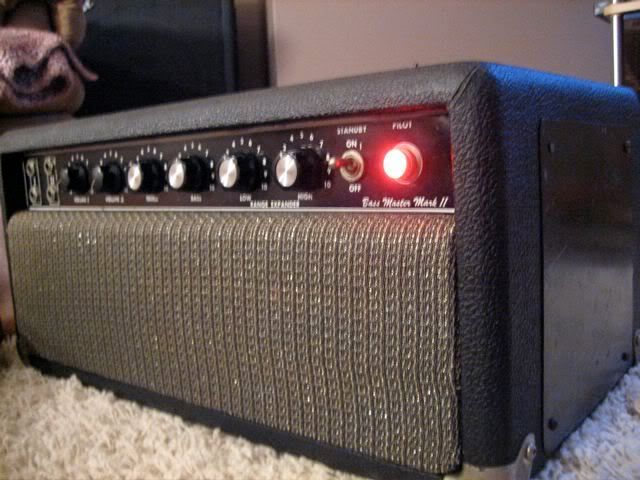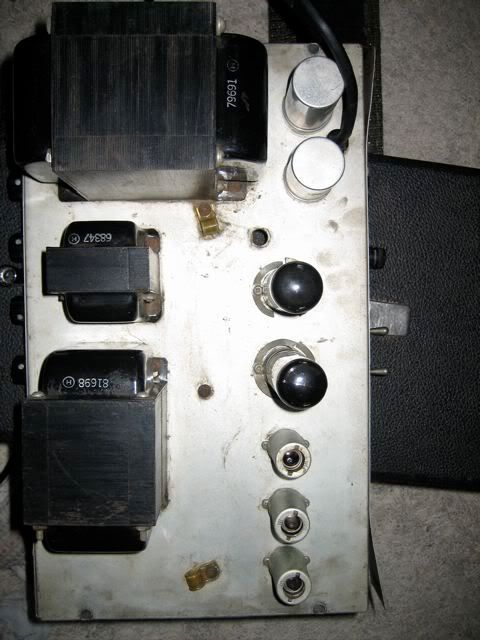Page 1 of 2
yet another traynor post
Posted: Fri Apr 13, 2007 1:53 pm
by owen_Archive
i really tried to avoid posting this because there are so many traynor threads, but i couldn't find this info in an older post. so...
i found a great deal on a YBA-1A. the guy who is selling it removed the fan. is this going to give me any problems? also it has the original 2 prog cable, and i want to install a 3 prong. is there an online tutorial floating around that could help me with this? is it possible for a novice such as myself to do this?
here are some pics of the amp to show where the fan was taken out. i think she looks pretty clean otherwise.
yet another traynor post
Posted: Fri Apr 13, 2007 2:14 pm
by Pure L_Archive
You could definitely do a grounded-cord installment yourself. Just be aware that you could be electrocuted by touching the wrong things in the amp (the large, filter caps and they're respective connections). Here's something for a Fender:
http://www.theguitarfiles.com/guitarfile644.html . I'm not too sure how a Traynor compares in terms of it's colors for neutral and hot leads. Is Traynor a Canadian company? You might want to know this before you start.
A fan couldn't hurt that amp but there are only 2 power tubes, aren't there?
If one was meant to be there, there's probably a tap for it.
Scott probably has a schematic for this and could help better than me.
yet another traynor post
Posted: Fri Apr 13, 2007 3:47 pm
by owen_Archive
can i get the cable at radio shack or someplace like that? do i need any special tools other than a soldering gun?
yet another traynor post
Posted: Fri Apr 13, 2007 3:55 pm
by scott_Archive
are you in chicago by any chance?
the fan is not an absolute necessity, though you should definitely get one in there. the YBA-1A (and YBA-3 also) run the tubes at higher voltage than pretty much any amp out there (higher than any Fender or Marshall by quite a bit) which is how they manage to get 90 watts out of two tubes that would generally get you half that much.
yours is a 60's model, which is nice. the fan on those runs directly off the AC power coming from the wall, so the wiring scheme mentioned above won't exactly work, with a fan.
you should get a new fan.
if you want to get a low-voltage fan instead of a fan like it originally came with, you can wire it up to work off the tubes' filament voltage supply instead... if you get a fan that will run off 12V AC, when it sees the 6.3V AC for the filament supply, that should be enough to run it, though it'll run at lower than its design speed, which will mean it'll be quieter. if you get a really high-volume (air movement volume, not sound level volume) fan, you should be in great shape.
as far as how to wire up the grounded power cord... just get one as described above, with the metal ring on the green wire... connect the green wire's ring to one of the bolts that hold the power transformer in place. they have two nuts per bolt, usually, since one of the bolts is used to hold the clamp bracket thing that holds the big paper capacitors in place. just make sure that the green wire's metal ring is very securely held by one of those bolts, and that's good.
as far as where to connect the other two wires (white and black), just connect them where the current plug's wires are connected. that would most likely be one wire to the accessory outlet, and the other wire to the ground selector switch.
and the capacitor that goes from the ground selector switch (known as "the death cap" because if that cap fails, it can lead to your electrocution, hence the reason to remove it once the grounded plug is in) cut that thing the hell out of there once you have the grounded plug in.
and yeah, be careful what you're touching while you're in there. all this stuff with wiring a new plug, you're right near the metal can caps and the more dangerous big brown paper caps that you'll find inside. all those caps should be replaced.
are you in chicago by any chance?
yet another traynor post
Posted: Fri Apr 13, 2007 4:00 pm
by owen_Archive
thanks scott for the info. i dont move into logan square until july 1st. right now i am stuck in central illinois for a bit longer.
yet another traynor post
Posted: Fri Apr 13, 2007 4:24 pm
by scott_Archive
I get my power cables from triode as well, sometimes, though lately I've been more into buying 15' or 20' orange indoor/outdoor 3-prong extension cables, and then cutting the female end off and stripping the wires. It's kinda awesome to not have to worry how close you are to the power outlet. The only thing you need to worry about then is, like BadC said, crimping a ring on, or you can do it the way I do it, which is to strip down the end of the wire, bend it into a U-shape that's just the right size to fit around the bolt you're gonna connect it onto, and then tinning it with solder to make it all nice and rigid and stuff. The big downside from the cables you get from a place like Triode is that they're not super long. I like at least a good 10', if not more.
I forgot to mention what is one of the trickiest parts, or can be the most frustrating sometimes... the power cable enters the chassis through a hole (duh) but it has a plastic cable retainer thingy, just a piece the size of a gumdrop or something that holds the cable in place. If you tug on the power cable, the retainer holds the cable in place at the chassis, so that tugging is not translated onto your solder joints. It would be bad if, say, you pulled on the cable on accident, and then it ripped one of the connections loose inside the chassis. Sparks and fuses and circuit breakers blowing kinda bad.
The trick to those things is, you need to use pliers, like a snub needlenose kind or the like, to squeeze the retainer together while you push it through the hole. Squeezing and pushing it through is the easy part. The tricky part is, once you have the new cable ready to be put in, and you put the retainer on it, and you need to squeeze it and put it back *in*. The cable you put in is going to be thicker than the one you took out, as it has three conductors instead of just two. So it's a tighter fit. It can be a little bit of a pain in the ass, but it just takes a little time and a little getting used to.
I would recommend that you get your new power cable all prepped, with the wires stripped down and tinned and whatnot, and then feed the ends of the cables through the hole, and then put the retainer onto the cable where it will give you the right amount of cable length inside the chassis to get the wires to where you need them, but not a lot more since that'd be messy, and then squeeze the retainer into place. And *then* make your solder connections.
If you have a chance to make the trip up to Chicago before you move up here, some weekend or something, I'd be glad to help you out with it.
Are you sure the amp is in good operating condition right now? Aside from the power cord, which you really ought to do, and the new fan, which you really ought to do, there's the question of at least testing the caps to make sure they're okay, if not outright replacing them, and also making sure the bias voltage is set properly, assuming the output tubes are in good working order.
yet another traynor post
Posted: Sun Apr 22, 2007 2:37 pm
by Laura Bushs Bush_Archive
Unless you absolutely know what you are doing, do not open any amplifier and start poking around!!!!
yet another traynor post
Posted: Mon Apr 23, 2007 4:52 pm
by owen_Archive
so the Traynor comes in the mail today and she doesnt seem to be working. The tubes fire up and I get zero sound unless I turn it up to almost 10. While at 10 it is quiet. The sound that does come out is very distorted, and resembles that of a bass synth, the note sustains for about 2 second then "sizzles" out. I tried all 4 inputs, plugging it into my Kasino 2x15 as well as my Marshall JCM 800 4x12, both with the same result. I tried playing it with a bass and a guitar...same exact sound. any ideas?
yet another traynor post
Posted: Mon Apr 23, 2007 5:02 pm
by scott_Archive
I sure hope you're using the jack marked "speaker" as opposed to "extension". it's crucial. you could be killing your output transformer if you're not using the correct jack.
do you have a meter that can measure resistance? if so, turn the amp off (hell, unplug it while you're at it), plug a speaker cable into the speaker jack (not extension speaker) and measure the resistance between the tip and the sleeve of the plug on the other end (ie the end that you would plug into the speaker). what's the resistance?
yet another traynor post
Posted: Mon Apr 23, 2007 5:06 pm
by owen_Archive
i ONLY used the speaker input. sadly i dont own a meter.











